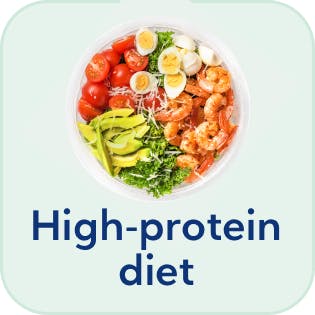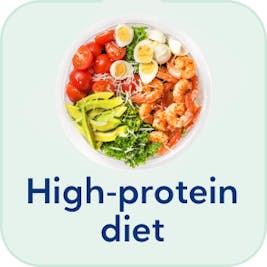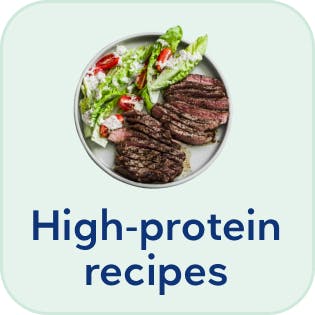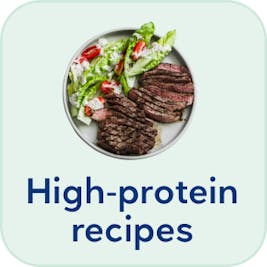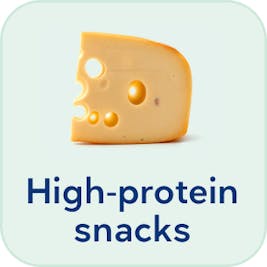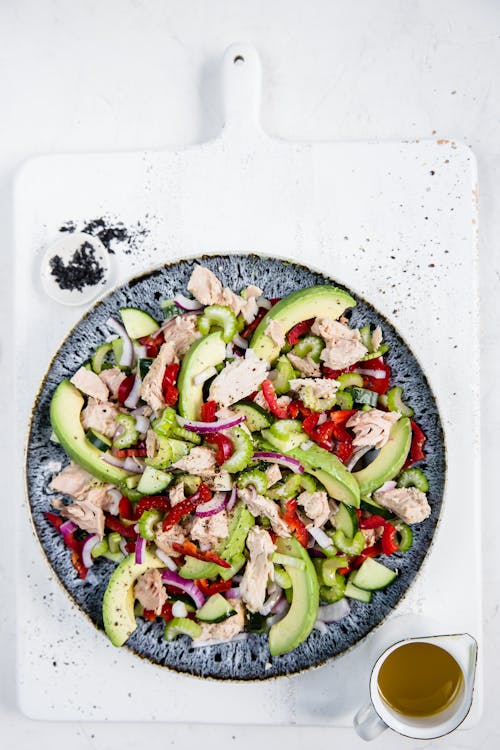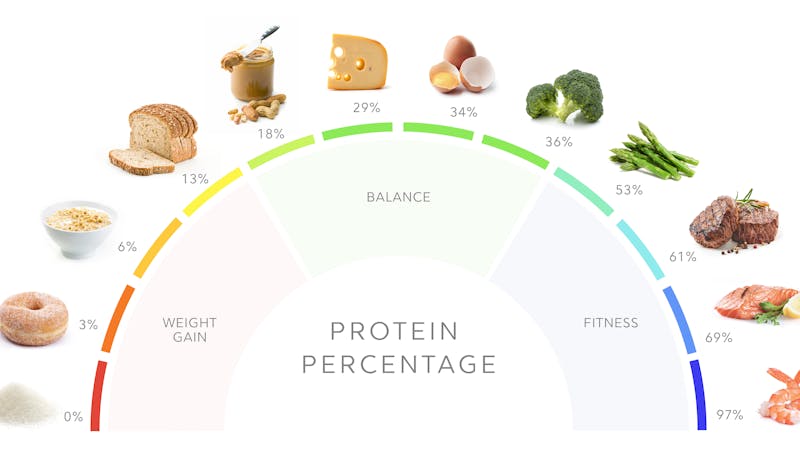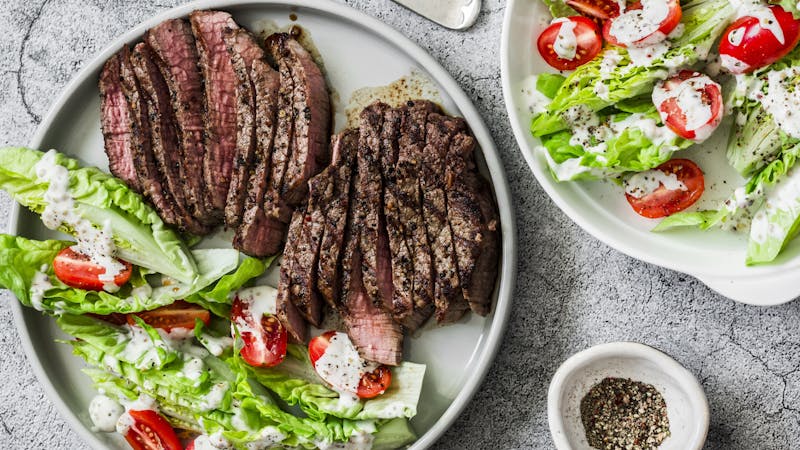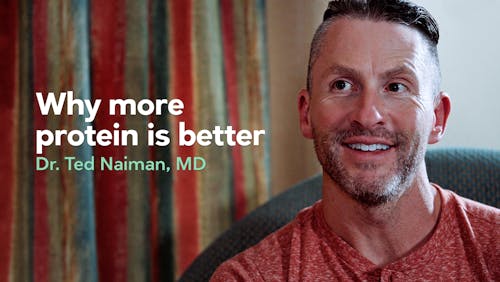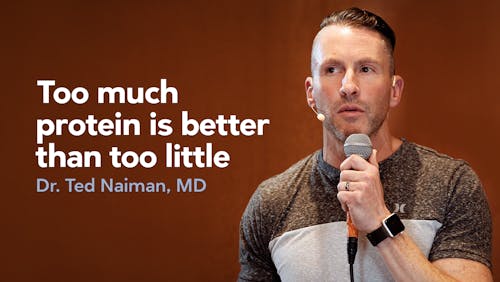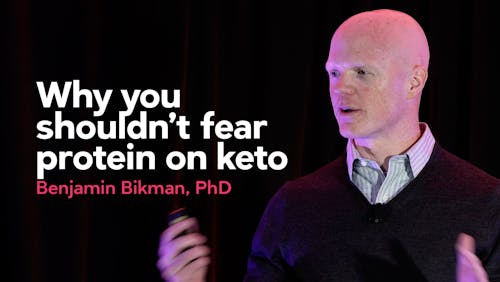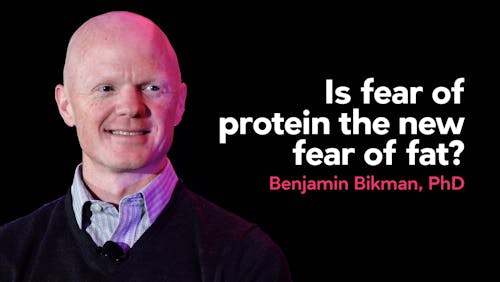Top 20 questions about high protein diets
- What are high protein diets?
- Is keto the “wrong” way to lose weight?
- Will a focus on higher protein make food choices for weight loss more complicated?
- What does it mean to use fat for flavor?
- Is a higher protein, low carb diet more effective for weight loss than a keto diet that emphasizes high fat?
- Is a higher protein intake right for me?
- Can you eat too much protein?
- Does excess protein turn to sugar?
- Will eating more protein kick me out of ketosis?
- Don’t I need to add more fat to my keto diet in order to feel full?
- Don’t I need to add extra fat to my keto diet in order to be in ketosis and burn fat?
- What do higher protein recipes and meal plans look like?
- Does this mean I’ll be eating tasteless “diet food”?
- Is a higher protein diet more expensive?
- Will it mean more cooking?
- What is “protein percentage”?
- What is “satiety per calorie”?
- What is “energy density”?
- Why is DD expanding its options to include high protein recipes and meal plans?
- Why is Diet Doctor now talking about calories?
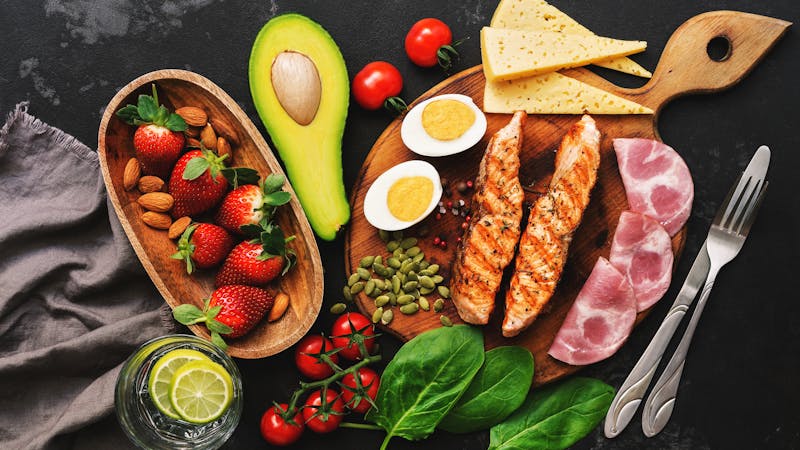



1. What are high protein diets?
The recommended daily allowance (RDA) for protein is 0.8 grams per kilo, an amount set by the US Institutes of Medicine. This amount is the minimum requirement to prevent malnutrition, not to improve health.
For an average male, that’s 56 grams of protein per day — about 6 ounces of steak. For an average female, it’s 46 grams per day.1
We define an adequate protein diet as over 1.2 grams per kilo per day or more than 20% of calories – although that may seem “high” because it is above the RDA. We recommend that most people aim for 1.6 to 2 grams of protein per kilo or 25-35% of calories from protein, and we use those numbers as the basis for our “high protein” recommendations.
Use this simple chart to find out what your minimum daily protein target should be, based on your height.2
Minimum daily protein target
| Height | Women | Men |
|---|---|---|
| Under 5’4″ ( < 163 cm) | 90 grams | 105 grams |
| 5’4″ to 5’7″ (163 to 170 cm) | 100 grams | 110 grams |
| 5’8″ to 5’10” (171 to 178 cm) | 110 grams | 120 grams |
| 5’11” to 6’2″ (179 to 188 cm) | 120 grams | 130 grams |
| Over 6’2″ (188 cm +) | 130 grams | 140 grams |
By comparison, American men average 88 grams of protein per day, and women average 66 grams. This equates to only 14 to 16% of total calories, far less than our definition of high protein intake.3 Of those protein calories, approximately 30% come from plant sources.4
Since you may be consuming a lower amount of protein, you may consider our recommendation for adequate protein to be “high,” so we refer to these diets as high protein diets.
2. Is keto the “wrong” way to lose weight?
There are many ways to lose weight in a healthy way, and a very low carbohydrate, ketogenic diet can be one of them.
All healthy weight loss diets have a few things in common. Any healthy weight loss diet should:
- provide your body with plenty of protein, plus essential nutrition from vitamins, minerals, and fatty acids.
- provide enough calories for energy but somewhat less than daily needs in order to allow for weight loss.
- reduce metabolically unhealthy body fat while preserving or building appropriate muscle and bone mass.
- maintain or improve energy levels and sense of well-being.
- improve health markers such as glucose, lipids, waist circumference, and blood pressure.
- not inappropriately reduce your basal metabolic rate.
If your keto diet does all of these, as it does for many people, it’s the right diet for you.
But a keto diet combined with higher amounts of protein may be even more effective for some people. At least one small clinical trial in men with obesity, where participants were allowed to eat as much as desired, shows that a ketogenic diet combined with higher protein resulted in more weight loss and less hunger compared to a higher protein diet with a moderate amount of carbohydrates.5
3. Will a focus on higher protein make food choices for weight loss more complicated?
A focus on protein intake doesn’t have to mean more tracking or counting. Keeping track of your protein intake may be helpful at first, for a week or so, because many people do not have an accurate sense of how much protein they are consuming.
However, you can always keep it simple with these three steps:
- Reduce carbohydrates to 20 to 50 grams per day, or whatever level allows you to lose weight comfortably.
- Have a generous serving of protein at every meal, at least one to two palm-sized servings of high protein foods, such as eggs, meat, fish, or poultry.
- Add fat to your meals for flavor, just enough to make sure you enjoy the foods you’re eating. This means you can keep the skin on your chicken and add butter to your vegetables as you wish.
You may also need to add some fat to make up part of the calories lost when reducing carbohydrate foods — but with twice as many calories as carbs, not much fat is needed!
If this approach doesn’t help you move toward your weight loss and health goals, you may want to try tracking protein, carbohydrates, fat, and calories for a short while in order to get a better sense of what you can tweak for more success.
Or you can use our higher protein recipes that do the calculations for you. For even more structure to your higher-protien diet, you can use our meal plans, which are available with a free trial membership.
At Diet Doctor, we will continue to develop visual guides, informative videos, and other resources to make eating a higher protein diet easy and accessible.
4. What does it mean to use fat for flavor?




In order for a way of eating to be sustainable, it also has to be enjoyable. Adding fat for flavor means you can put butter or cheese sauce on vegetables that would be bitter or boring otherwise. You can add a rich sauce to lean pork loin or chicken breast to bring out flavor and avoid dryness.
The key to using fat for flavor is not to drown your food in fat so that all you taste is butter, cheese, or mayonnaise. Instead, use just enough to enhance your enjoyment of the food itself.
5. Is a higher protein, low carb diet more effective for weight loss than a keto diet that emphasizes high fat?
The truth is that we don’t know for sure if a higher protein, low carb diet is more effective for healthy weight loss than a keto diet that emphasizes high fat. Not enough head-to-head trials exist to answer that question. But for some specific people, a higher protein low carb diet may be the better choice (i.e. those who have struggled on low carb or stalled in their progress).
A diet that is higher in protein may be more effective for some in achieving and maintaining weight loss due to increased feelings of fullness and an improved body composition that favors preserving muscle mass during weight loss.6
A diet that is higher in protein is likely to be higher in nutrition in general. With a high protein approach, you will get all the nutrients you need to keep muscles, bones, and metabolism in good shape.
A keto diet that emphasizes fat intake rather than protein may require more calories to provide the body with adequate essential nutrition compared to higher protein diets. Refined forms of fat — such as butter and olive oil — add a lot of calories without a lot of nutrition. While added fat may help many people with energy needs and satiety, the added fat may prevent some people from maintaining a sustainable calorie deficit.7
Even though counting calories is frequently not a sustainable approach to weight loss, calories still count in losing and maintaining weight loss. With a higher protein diet, you may be more able to make every calorie count towards essential nutrition and a healthy metabolism.
But, as we have mentioned before, if you are eating a keto diet emphasizing added fats and you are getting adequate nutrition, managing your hunger, and succeeding with your healthy weight loss goals, then there is no need to change your eating habits. Keep up the great work!
6. Is a higher protein intake right for me?




If you are interested in changing your body composition to build muscle and reduce body fat, a higher protein approach may be more effective than a traditional keto diet.8
If you love protein-rich foods and you don’t enjoy the higher fat content of a keto diet, you might prefer a higher protein approach. Having meals that are enjoyable will help you succeed in reaching your health goals.
If you want more flexibility in food choices, a higher protein, lower fat diet might be right for you. By increasing protein and cutting back on fat, you may find that you can add some fruit, legumes, or whole grains to your meals and still lose weight.
However, if you are eating a keto diet for reasons other than weight loss, such as mental health or neurological benefits, then reducing fat and eating more protein may not be right for you. If you are using a keto diet as part of a medical treatment program, please consult with your doctor before making any changes.
7. Can you eat too much protein?
There is a possibility that one could eat “too much” protein, but it would be very difficult to do in actuality.
The Acceptable Macronutrient Distribution Range (AMDR) set by the US Institute of Medicine is 10 to 35% of calories. At the higher end, 35% protein for a daily caloric intake of 2,000 calories is 175 grams of protein. If your calorie needs are higher, then your protein intake might be higher as well.
The theoretical maximum safe intake for liver and kidney function is a diet with around 70% protein. 9 For a person who is 176 pounds (80 kilos), this would be 365 grams of protein per day. It is unlikely that, under normal circumstances, anyone would overeat protein to this extent.
8. Does excess protein turn to sugar?
In order to answer that question, we would first have to know what your body considers to be “excess” protein.
If you have been chronically undereating protein and you increase your intake, your body will likely put nearly all dietary protein to good use building muscle, bone, and other essential tissues, hormones, and enzymes. You may feel like you are eating “too much” protein, but your body may disagree!10
In fact, older adults may have higher protein needs. Individuals with obesity, prediabetes, or type 2 diabetes may also benefit from a diet that is higher in protein.11 Additionally, your gut can regulate the timing of the release of amino acids into the bloodstream, temporarily storing some and releasing them later.12 The gut itself will use more amino acids when they are plentiful and less when they aren’t.
Both mechanisms serve to make sure the body gets just the right amount of amino acids it needs, even when intake of protein varies. As a result, your body is less likely to have an “excess” of amino acids.
Overall, dietary protein doesn’t contribute much to the production of of glucose. 13 While some amino acids can be converted into glucose, some organs, tissues, and cells in the body require glucose. That glucose will come mainly from glycogen stores, but it can also come from what little glucose may be produced from protein.
The bottom line is that in our clinical experience, “excess” protein intake is far less of a problem than inadequate protein intake, which can lead to muscle and bone loss, as well as a slowing of your metabolism.
9. Will eating more protein kick me out of ketosis?




Ketosis is an outcome of fat metabolism; ketones don’t cause your body to burn fat. In other words, there’s no need to add “extra” fat to your food to reach a particular level of ketosis if your primary health goal is weight loss.15
10. Don’t I need to add more fat to my keto diet in order to feel full?
The answer to this question will vary by individual. However, calorie for calorie, protein foods and high-fiber vegetables are better than fat at helping your body to feel full with fewer calories.16 That doesn’t mean fat can’t also help you feel full. It definitely can. But fat provides more than twice as many calories per gram as does protein or carbs. So, protein and fiber-filled foods may help you feel full with fewer calories than fat.
If you are experiencing hunger between meals, make sure each meal has:
- Plenty of protein: You may need more than you think you do. Most people will do well with 25 to 35 grams of protein per meal. This is the equivalent of four eggs! So if you think a “high protein” meal is two eggs, you are only halfway there.
- High-fiber vegetables: Fiber slows down digestion and provides bulk that stretches the stomach to signal fullness. Find creative ways to include vegetables at every meal, including breakfast.
- Adequate calories: If you are not getting enough calories, you may need to add fat to your meals. But remember that fat has nine calories per gram (compared to protein and carbs, which have four), so a little bit of fat can add up to a lot of calories quickly.
Also, keep in mind that fat plus a sweet taste can stimulate your brain’s food reward centers. Fat combined with a keto-friendly, non-caloric sweetener can promote hunger, override feelings of fullness, and make it easy to overeat empty calories.17
11. Don’t I need to add extra fat to my keto diet in order to be in ketosis and burn fat?
A keto diet works because it lowers carbohydrate intake to a level where the body shifts to burning fat for fuel instead of glucose.18 Lowering carbohydrate intake automatically raises the fat percentage of the diet, but you may — or may not — increase the absolute amount of fat that you eat.
Carbohydrate reduction is what increases the body’s ability to burn fat in general — both dietary and body fat. Keeping fat intake at the right level for you increases the body’s ability to burn its own fat. This level may vary from person to person.19
If you keep your insulin low by eating fewer carbs — but keep your calorie intake higher than you need — you can limit the body’s ability to burn its own fat for fuel.
Ketones are an outcome of burning fat. Achieving a certain ketone level may be beneficial for other health reasons, but is not necessary for weight loss.20
12. What do higher protein recipes and meal plans look like?
Higher protein recipes and meal plans will focus first on providing essential nutrition, especially protein. They will avoid adding a lot of calories from fat and will ensure that calorie levels of recipes and meal plans are appropriate for weight loss.
Keep in mind, however, that our recipes that are lower in fat are still a long way away from “low fat.” For example, some recipes may have 60% fat calories instead of 75%. That’s still plenty of fat for you to enjoy!
For our higher protein recipes, we will continue to offer three levels of carbohydrate reduction: keto (10 grams of carbs or fewer per recipe); moderate (20 grams or fewer); and liberal (35 grams or fewer).
By targeting foods that are high in protein and other nutrients, our recipes and meal plans will help you meet your essential nutrition needs and keep you feeling full, which can help you lose weight.
But don’t worry. Our recipe team will make sure recipes that are high in protein are also still delicious. Additionally, we’re working to bring you recipes for tasty snacks and desserts that will help you to up your protein intake without a lot of extra calories.
13. Does this mean I’ll be eating tasteless “diet food”?
A high protein, low carb or keto diet is still high in fat. With 5 to 10% of calories from carbohydrates and 30 to 35% of calories from protein, that still means that about 60% of calories will come from fat. That allows for plenty of fat to be added to make food taste good.
14. Is a higher protein diet more expensive?
It is true that protein foods tend to be more expensive than other foods at the grocery store. But smart food choices can keep your grocery bill under control even when eating a higher protein diet.
Some things you can do to make sure you are getting the most out of your grocery dollar:
- Shop weekly sales at your grocery store.
- Buy in bulk and freeze the extra for later use.
- Choose less expensive cuts, including ground meats.
- Include eggs, an inexpensive and versatile form of protein.
- Consider adding legumes, if your carb tolerance allows, as beans are an inexpensive source of protein.
15. Will it mean more cooking?
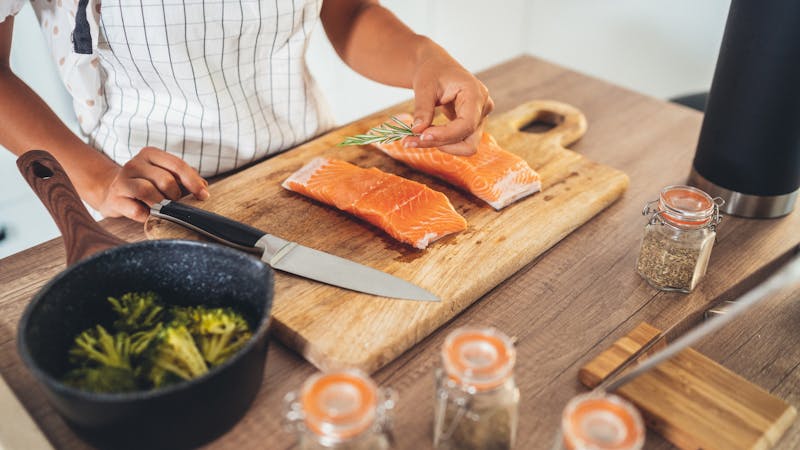



Try hard-boiling a dozen eggs for quick protein anytime. Leaner deli meats, such as sliced turkey or ham, can be paired with a slice of cheese and rolled around a pickle spear for lunch on the go. Grab a rotisserie chicken from the grocery store, and you’ll have chicken chunks to add to salads, soups, or casseroles that need a protein boost.
We have a list of 21 high protein snacks to make getting your daily dose of protein quick and easy.
And, although we don’t recommend relying on them every day, prepackaged protein shakes and fast-food burgers minus a bun can help you meet your protein goals when you are traveling or in a hurry.
16. What is “protein percentage”?
The “protein percentage” of a food reflects how much protein contributes to a food’s total calories, excluding calories from fiber.
Fiber calories aren’t included because fiber isn’t broken down and absorbed by your digestive tract, unlike other carbohydrates. Therefore, fiber doesn’t provide your body with calories.
17. What is “satiety per calorie”?
Satiety per calorie essentially means how full you feel compared to how many calories you’ve eaten. To lose weight, you want to feel as full as possible with the least amount of calories. High protein foods — such as salmon, chicken breast, and lean steak — provide the greatest satiety per calorie, along with low “energy density” foods like fiber-filled veggies because of their higher volume, fiber, and water content.21
These food have a low satiety value per calorie:
- High energy density foods, such as high carb/high fat ultra-processed foods, like donuts and chips
- Refined fats that are removed from naturally occurring protein, such as butter and oils22
- Non-caloric sweetener-containing foods combined with refined fats
Sugar-sweetened foods are considered low-satiety, even if they are not high in calories, as they are more likely to trigger cravings.
For healthy weight loss, food choices should be high satiety per calorie. The goal is to reduce hunger with the fewest calories. Dramatically reducing carbohydrates is a good strategy for increasing satiety per calorie, as long as excessive fat is not added.
18. What is “energy density”?
Energy density is the amount of energy or calories in a specific weight of food. It is usually expressed as calories per gram.
In most cases, foods with lower energy density are better for weight loss as they contain fewer calories per gram of food. Low energy-density foods allow us to eat a greater volume which adds to satiety.
For people dealing with insulin resistance, foods that are both low in energy and low in digestible carbohydrates — such as high-fiber, low-starch vegetables — are excellent choices for weight loss.
However, energy density is only one factor in losing weight in a healthy way. You must still make sure you get the nutrients you need. While a lot will come from vegetables, you’ll also need high protein foods to supply essential amino acids. You can get the protein you need from animal sources or from plant sources.
19. Why is DD expanding its options to include high protein recipes and meal plans?
We know that most visitors come to our site for help with weight loss and we want to guide these individuals on how to lose weight in the healthiest way possible. Evidence indicates that higher protein weight loss diets help preserve muscle, bone, and metabolic health.23 We believe that a focus on protein intake is an important part of healthy weight loss.
Additionally, we know that some visitors to our site experience a lack of progress on keto, and we want to make sure that we offer other healthy options for success, rather than just telling those individuals to “keto harder.”
If you are doing keto, and it’s working well for you, that’s great! If not, we think we have the solution. Increasing protein may help carbohydrate reduction work even better.
At Diet Doctor, we have an obligation to re-evaluate our guidance in light of new information and a new understanding of existing information.24
Furthermore, our re-evaluation of existing studies has prompted us to rethink the importance of protein’s role in weight loss and metabolic health.
Clinical trials that show that carbohydrate reduction is beneficial for weight loss usually also feature an increase in protein or protein percentage. Higher protein diets appear to work well for weight loss and improved metabolic health, even in the absence of dramatic carbohydrate reduction.25
High protein recipes
20. Why is Diet Doctor now talking about calories?
In the past, we have not recommended counting calories because our recipes and meal plans are designed to count them for you.
Additionally, by focusing on calories, many people are misled into thinking that the types of food you eat don’t matter — just the number of calories. Instead, we wanted to encourage people to listen to their own feelings of hunger and fullness, rather than a number on a package or recipe.
However, we do recognize that calories matter, especially if you are trying to lose weight or improve your metabolic health. If you take in more calories than you need on a daily basis, your body still has to deal with that excess energy. This may result in weight gain or worsening insulin resistance.26
At the same time, you don’t want your calorie intake to go too low for an extended period of time. Chronic caloric restriction can slow your metabolism.27 Getting sufficient calories is just as important as not overdoing calories, even during weight loss.
If you’re trying to lose weight and you prefer to make your own recipes, you may need to count calories at first. Once you get used to reducing carbs and getting plenty of protein, you may find that adding the right amount of fat for your desired calorie level becomes automatic.
Learn more about protein
Top 20 questions about high protein diets - the evidence
This guide is written by Adele Hite, RD and was last updated on June 19, 2025. It was medically reviewed by Dr. Bret Scher, MD on May 19, 2021.
The guide contains scientific references. You can find these in the notes throughout the text, and click the links to read the peer-reviewed scientific papers. When appropriate we include a grading of the strength of the evidence, with a link to our policy on this. Our evidence-based guides are updated at least once per year to reflect and reference the latest science on the topic.
All our evidence-based health guides are written or reviewed by medical doctors who are experts on the topic. To stay unbiased we show no ads, sell no physical products, and take no money from the industry. We're fully funded by the people, via an optional membership. Most information at Diet Doctor is free forever.
Read more about our policies and work with evidence-based guides, nutritional controversies, our editorial team, and our medical review board.
Should you find any inaccuracy in this guide, please email andreas@dietdoctor.com.
In contrast, the RDA for carbohydrate, a non-essential macronutrient, is 130 grams per day. However, Americans typically eat at least twice that much.
What We Eat in America 2017-2018: Nutrient intakes from food and beverages [overview article; ungraded]
↩In this case, height is a proxy for Reference Body Weight. Reference Body Weight is a way of estimating how much lean body mass a person of a specific height would have and thus how much protein they need on a daily basis. ↩
American Journal of Clinical Nutrition 2018: Protein intake trends and conformity with the Dietary Reference Intakes in the United States: analysis of the National Health and Nutrition Examination Survey, 2001-2014 [observational study, weak evidence]
American Journal of Clinical Nutrition 2008: Current protein intake in America: analysis of the National Health and Nutrition Examination Survey, 2003-2004 [observational study, weak evidence] ↩
The following observational study reported that the average intake is as follows: Animal 46%, dairy 16%, plants 30%, and undefined 8%.
Nutrients 2015: Sources and Amounts of Animal, Dairy, and Plant Protein Intake of US Adults in 2007-2010 [observational study, weak evidence] ↩
American Journal of Clinical Nutrition 2008: Effects of a high protein ketogenic diet on hunger, appetite, and weight loss in obese men feeding ad libitum [randomized trial; moderate evidence]
↩American Journal of Clinical Nutrition 2003: Effect of a high protein, energy-restricted diet on body composition, glycemic control, and lipid concentrations in overweight and obese hyperinsulinemic men and women [randomized trial; moderate evidence]
Nutrients 2019: Pretreatment fasting glucose and insulin as determinants of weight loss on diets varying in macronutrients and dietary fibers-the POUNDS LOST study [randomized trial; moderate evidence]
International Journal of Obesity 2015: The role of higher protein diets in weight control and obesity-related comorbidities [overview article; ungraded]
↩This is based on the consistent clinical experience of practitioners familiar with low carb nutrition. [weak evidence] ↩
We are not aware of any head-to-head studies which measured body composition and compared a traditional keto diet versus a higher protein diet. However, based on studies demonstrating improved body composition with higher protein diets, it is our belief that higher protein diets will improve body composition for most people better than a traditional keto diet. ↩
International Journal of Sports Nutrition and Exercise Metabolism 2006: A review of issues of dietary protein intake in humans [overview article; ungraded] ↩
American Journal of Clinical Nutrition 2006: The underappreciated role of muscle in health and disease [overview article; ungraded] ↩
American Journal of Physiology-Endocrinology and Metabolism 2016: Does the muscle protein synthetic response to exercise and amino acid-based nutrition diminish with advancing age? A systematic review [overview article; ungraded]
Nutrition & Metabolism 2011: Skeletal muscle protein metabolism in the elderly: Interventions to counteract the ‘anabolic resistance’ of ageing [overview article; ungraded]
Journal of the American Medical Directors Association 2013: Evidence-based recommendations for optimal dietary protein intake in older people: a position paper from the PROT-AGE Study Group [overview article; ungraded]
International Journal of Obesity 2015: The role of higher protein diets in weight control and obesity-related comorbidities [overview article; ungraded]
Frontiers in Endocrinology 2018: Dietary protein and energy balance in relation to obesity and co-morbidities [overview article; ungraded]
Diabetes 2004: Effect of a high protein, low carbohydrate diet on blood glucose control in people with type 2 diabetes [randomized trial; moderate evidence]
Nutrition, Metabolism, and Cardiovascular Diseases 2020: High protein diet leads to prediabetes remission and positive changes in incretins and cardiovascular risk factors [randomized trial; moderate evidence]
↩International Journal of Sport Nutrition and Exercise Metabolism 2007: Absorption kinetics of amino acids, peptides, and intact proteins [overview article; ungraded] ↩
Diabetes 2013: Dietary proteins contribute little to glucose production, even under optimal gluconeogenic conditions in healthy humans [non-controlled study; weak evidence]
↩Diabetes Care 1991: Plasma glucose and insulin response to macronutrients in nondiabetic and NIDDM subjects [randomized trial; moderate evidence]
↩This is based on the consistent clinical experience of practitioners familiar with low carb nutrition. [weak evidence] ↩
European Journal of Clinical Nutrition 2018: Dietary fat, fibre, satiation, and satiety—a systematic review of acute studies [systematic review of randomized trials; strong evidence]
American Journal of Clinical Nutrition 2008: Protein, weight management, and satiety [overview article; ungraded]
↩Fat Detection: Taste, texture, and post ingestive effects: 2010 [overview article; ungraded]
↩The physiology of ketone production and utilization has been well described in the medical literature. Below are 3 review articles that expand into more detail about the process:
Diabetes and Metabolism Reviews 1989: Ketone body production and disposal: effects of fasting, diabetes, and exercise. [overview article; ungraded]
Annual Reviews in Biochemistry 1980: Regulation of hepatic fatty acid oxidation and ketone body production. [overview article; ungraded]
Annual Reviews in Nutrition 2006: Fuel metabolism in starvation. [overview article; ungraded] ↩
This is based on the consistent clinical experience of practitioners familiar with low carb nutrition. [weak evidence] ↩
For example, the keto diet intervention study run by Virta health demonstrated significant weight loss and blood sugar benefits with an average ketone level of only 0.4mmol/L.
Diabetes Therapy 2018: Effectiveness and safety of a novel care model for the management of type 2 diabetes at 1 year: an open-label, non-randomized, controlled study [weak evidence] ↩
European Journal of Clinical Nutrition 2018: Dietary fat, fibre, satiation, and satiety—a systematic review of acute studies [systematic review of randomized trials; strong evidence]
↩This doesn’t mean that refined fats aren’t satiating foods. They certainly can be for many people. But they are satiating at higher calorie levels than higher protein and fiber-filled foods. ↩
Multiple studies show higher protein intake helps with weight loss, specifically fat mass loss. The first study reports improved body composition and weight loss with no reduction in fat-free mass or resting energy expenditure on a high protein diet in overweight women.
Nutrients 2018: Effects of Adherence to a Higher Protein Diet on Weight Loss, Markers of Health, and Functional Capacity in Older Women Participating in a Resistance-Based Exercise Program
[randomized trial; moderate evidence]The following study, a 12-week intervention in obese women, also reports more significant fat mass loss with a 25% protein diet than a 15% protein diet.
British Journal of Nutrition 2020: The effect of 12 weeks of euenergetic high protein diet in regulating appetite and body composition of women with normal-weight obesity: a randomised controlled trial
[randomized trial; moderate evidence]And the next two examples also report similar results:
International Journal of Obesity Related Metabolic Disorders 2004:
Effect of normal fat diets, either medium or high in protein, on body weight in overweight subjects: a randomised 1-year trial[randomized trial; moderate evidence]Endocrine, Metabolic, and Immune Disorders of Drug Targets 2020:
Effects of a Low Carb Diet and Whey Proteins on Anthropometric, Hematochemical, and Cardiovascular Parameters in Subjects with Obesity [nonrandomized study, weak evidence]And the following systematic review of RCTs shows the benefits of high protein diets on metabolic health.
British Journal of Nutrition 2013: Effects of high protein diets on body weight, glycaemic control, blood lipids and blood pressure in type 2 diabetes: meta-analysis of randomised controlled trials
[systematic review of randomized trials; strong evidence] ↩A clinical trial, comparing a healthy, low fat diet and a healthy, low carb diet, showed no differences in weight loss over the 12 months of the study. Both diets emphasized vegetable intake; limited added sugars, refined flours, and trans fats; and focused on whole foods, but did not restrict calories. The low carb diet started as a keto diet for three months and then allowed for liberalization of carb intake.
In this study, there were no significant differences in terms of which diet worked better among participants who had higher baseline insulin secretion levels. In other words, a low carb diet, which is meant to lower insulin levels by reducing dietary carbohydrates, did not work better than a low fat diet for weight loss for individuals with higher baseline insulin levels.
Journal of the American Medical Association 2018: Effect of low fat vs low carbohydrate diet on 12-month weight loss in overweight adults and the association with genotype pattern or insulin secretion: The DIETFITS randomized clinical trial [randomized trial; moderate evidence]
In this short-term study, both the low fat and the ketogenic diet lead to improvements in fasting glucose, insulin, and markers of inflammation compared to baseline.
Nature Medicine 2021: Effect of a plant-based, low fat diet versus an animal-based, ketogenic diet on ad libitum energy intake [randomized trial; moderate evidence]
↩International Journal of Obesity 2015: The role of higher protein diets in weight control and obesity-related comorbidities [overview article; ungraded]
Physiology & Behavior 2012: Relatively high protein or ‘low carb’ energy-restricted diets for body weight loss and body weight maintenance? [randomized trial; moderate evidence]
ESC Heart Failure 2021: High‐protein vs. standard‐protein diets in overweight and obese patients with heart failure and diabetes mellitus: findings of the Pro‐HEART trial [randomized trial; moderate evidence]
↩Science and Translational Medicien 2015: Excessive caloric intake acutely causes oxidative stress, GLUT4 carbonylation, and insulin resistance in healthy men[non-controlled study; weak evidence] ↩
Obesity (silver Springs) 2016: Persistent metabolic adaptation 6 years after “The Biggest Loser” competition. [observational study, weak evidence] ↩



